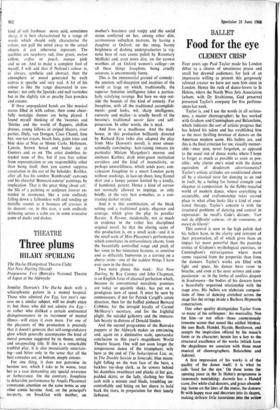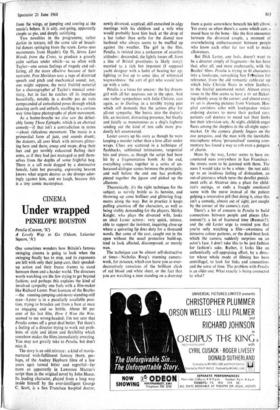Food for the eye
BALLET CLEMENT CRISP
Four years ago Paul Taylor made his London début to a chorus of unanimous praise and small but devoted audiences; for lack of an impresario willing to present this gorgeously talented creator we have not seen him since in London. Hence the rush of dance-lovers to St Helens, where the North West Arts Association (whom, with Dr Strabismus, God preserve) presented Taylor's company for five perform- ances last week.
Taylor is, and I use the words in all serious- ness, a master choreographer; he has worked with Graham and Cunningham and Balanchine, which indicates the sort of artistic progress that has helped his talent and has established him as the most thrilling inventor of dances on the American modern scene. His ballets are, and this is the final criterion for me, visually memor- able—once seen, never forgotten, as opposed to the usual run of dance works where I hope to forget as much as possible as soon as pos- sible: why clutter one's mind with the dance equivalent of deodorant advertisements? Taylor's artistic attitudes are conditioned above all by a classical taste for dancing as an end in itself, by a feeling for formal strength and elegance in composition. In the flabby-muscled world of modern dance, where everything is acceptable, and craftsmanship takes second place to what often looks like a kind of emo- tional therapy, Taylor's concern is with the structural problems of dancing and control in expression: he recall's Gides dictum : Tart nail de difficulte vaincue, vit de contrainte, et meurt de liberte: This control is seen in the high polish that ,. his ballets have, in the clarity and restraint of their presentation, all of which gives them an impact far more powerful than the paunchy erotics of Graham's mythological exercises, or Cunningham's extravaganzas where more seems required from the properties than from the dancers. Taylor's works are filled with light and space, his dances have room to breathe, and even at his most serious and corn- passionate—as in the limbo of soulless despair in Scudorama—the bodies of his dancers have a beautifully organised relationship with the stage area. His ballets are elaborate composi- tions of lines of dancing stretched across the stage like the strings inside a Barbara Hepworth construction.
One other quality distinguishes Taylor from so many of his colleagues : his musicality. Not for him—or not often—those anonymously tiresome scores that sound like addled Minkus. He uses Bach, Handel, Haydn, Beethoven, and accepts the inspiration offered by his music's form or its character; herein lies a key to the structural excellence of his works (which have the shapeliness we associate with those most musical of choreographers, Balanchine and Ashton).
A first impression of his works is of the quality of the dance itself; it is what he calls 'food for the eye.' On these terms the opening piece in the St Helen's programme is immensely nourishing; Aureole has a Handel score, five white clad dancers, and grace abound- ing; borne on the lines of the music, the dancers fit with happy ease and decorum into its shapes, making delicate little incursions into the action from the wings, or jumping and soaring at the music's behest. It is airy, out-going, apparently simple as pie, and deeply satisfying.
Two novelties in the programme, rather darker in texture, tell the same tale of beauti- ful dances springing from the score. Lento uses movements from Haydn's Op 51, Seven Last Words from the Cross, to produce a gravely calm surface under which—as so often with Taylor—one senses feelings of tragedy and suf- fering, all the more effective because of their restraint. Post Meridian uses a tape of distorted speech and pitch and mechanical sound; not, one might suppose, the most fruitful material for a choreographer of Taylor's musical sensi- tivity, but in fact he catches all its impulses beautifully, notably in a double pas de trois compounded of convoluted poses through which dancing curls and unfurls, recalling in a curious way time-lapse photographs of plant movement.
As a bonne-bouche we also saw the delect- ably funny Three Epitaphs, which is an abstract comedy—if that isn't a contradiction in terms —about ridiculous movement. The music is a primordial form of jazz, and sounds drunk; the dancers, all over black with mirrors glitter- ing here and there, creep and mope, drag their feet and get terribly exhausted flailing their arms, as if they had just managed to pull them- selves from the depths of some frightful bog. There is a tall male dogged by a diminutive female, faint but pursuing, expressing heaven knows what urgent desires as she droopskador- ingly against him, and we laugh, because this is a tiny comic masterpiece.







































 Previous page
Previous page